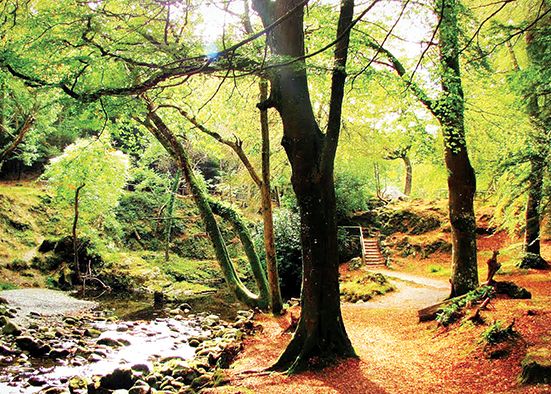Ghostly tales abound in the Mourne Mountains
Ghostly tales abound in the Mourne Mountains
26 October 2022

THE nickname ‘Kindly Mourne’ reflects the perception of the Mourne Mountains as a hiker’s paradise and a welcoming destination for a weekend away.
But there is mystery as well as majesty among our mountains. Local folklore is packed with stories about the ghosts and ghouls who lurk among the famous granite peaks.
Newcastle has an array of apparitions. The ‘Black Dog of the Rock’ is a donkey-sized dog with blazing eyes and sharp teeth that is, supposedly, seen near the rocks below St John’s Church. Locals say it belonged to the Earl of Annesley, who built the church in 1832.
Folklore frequently mentions black dogs as the custodians of church cemeteries, who guard against grave-diggers and other ill-doers. The Black Dog of the Rock may indicate that there are bodies buried nearby. What’s strange is that St John’s has no cemetery.
‘Jacqueline’ is another local spirit, who rides a black horse along the beach in front of the Slieve Donard Hotel, usually during a full moon.
The ‘Blue Lady of King Street’ is another ghostly figure sometimes seen not far from the Harbour, which itself is haunted by a banshee that moves among the moorings and is said to emit a high-pitched shriek. In Irish mythology, this supposedly forewarns of an imminent death.
Bogie Hill is behind the harbour, at the foot of Slieve Donard. It was where granite was transported down from the quarries – a ‘bogie’ was the name of a small railway cart. This is also where the ‘Old Widow of Bogie Hill’ stands.
Dressed all in black, she looks out to sea and can be heard sobbing. She was a relative of one of the 72 men who died in a fishing disaster in January 1843, when a freak storm hit a local fleet off the Mourne coast.
Further west, the old stately home at Tollymore Forest Park was also haunted by a woman. Staff used to hear chains and trunks being pulled across wooden floors. It may have been the presence of the ‘Blue Lady of Tollymore’ who, supposedly, migrated to the nearby barn and clock tower when the house was demolished after WW2.
Trassey Track is close to Tollymore and is a well-known entry point into the Mournes. At the start of the track there is a 19th century farmhouse. It used to be the Bush Hotel, named after Clonacullion Hill behind it (meaning ‘meadow of the holly bush’).
Even before being a hotel, this farmhouse was a known meeting point and drinking house for anyone coming off the mountains – especially the stonemen who worked the quarries. Many of them would see the apparition of an old lady standing in the kitchen doorway, close to the fireplace. She was never aggressive and just seemed to be watching over the property. Another theory is that she waits for the return of her relative who owned the house. He was James Devlin, who drowned in mysterious circumstances in the nearby Shimna River.
On passing this haunted farmhouse, most walkers hike towards Hare’s Gap or veer right and ascend to a small saddle between Slieve Bearnagh and Slieve Meelmore. Now known as Windy Gap, it used to be called Pollapúca Gap (‘Hole of the Fairies’).
A púca is a shape-shifting fairy or goblin that appears at night, often taking the form of a black horse with a flowing mane and piercing, luminous eyes. There have even been some famous púcas, including the animal in Jake Gyllenhaal’s 2001 film Donnie Darko, which appeared as a rabbit and encouraged Donnie to do malicious things. This reflects that púcas are temperamental and mischievous. They entice humans to take a ride on their back but then run wild until dawn, when the rider is thrown off to find their own way home.
Púcas are also associated with Samhain, the pagan festival marking the end of the harvest season on October 31 (the origin of Halloween). Traditionally, on completing the harvest, farmers would leave a few stalks to appease the púcas – known as the Púca’s Share.
If you pass Pollapúca Gap unscathed, you’ll reach Lough Shannagh (‘Lough of the Fox’) and you may see Sheelagh, who was the daughter of a local clan chief, and who would regularly join the men on hunts through the Mourne foothills. Such was her skill as a rider that, on one hunt, she broke away to chase a fox into the mountains. While the other riders tried to keep up, she was soon alone. Then the mist closed in. Visibility ped to zero. And the fox disappeared into a lough.
Yet Sheelagh pushed her horse on, until it was waist deep. She then tried to retrace the route back to dry land. But her horse just kept going deeper and deeper. Sheelagh never left that lough. Her family searched for days but never found her. It is said that, when the mist closes in, she is still seen splashing around on horseback, searching for the fox.
Sheelagh’s spirit never deterred Dermody, who used to illegally brew poteen around the lough, under the cover of darkness. But someone alerted the authorities and they scoured the hills for his hideaway. Dermody pushed his still into the lough to use it as a raft to make his escape. We can’t be sure if he succeeded. He was never seen again.
Slieve Binnian, one of the most distinctive Mourne peaks, sits to the east of Lough Shannagh. It is where the ‘Blue Light of Binnian’ is encountered. Locals say it appears as a ball of blue phosphorescent light that shoots over marshy ground, or sometimes along Head Road near Kilkeel. It is claimed
that this is the restless spirit of a young lady who was murdered and buried on Binnian’s slopes. Another theory is that it emerges to
block the path towards a clump of nearby haunted trees where an ancient chieftain is rumoured to be buried.
These are just some of the scary stories associated with the Mournes, reminding us that there is more to our mountains than meets the eye. If you head for a hike this Halloween, be warned that you may see some stunning scenery — but you may also get an unexpected scare.


